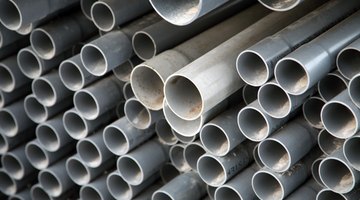What to Cut a CPVC Pipe With?
One of the advantages of working with chlorinated poly vinyl chloride (CPVC) pipe is that it requires no special skills to cut and shape and offers you a choice of cutting tools that require no expensive fuels, no heat or even electricity. Hand tools are all you need.

Saws
For years the primary CPVC cutting tool has been a fine toothed saw. A hacksaw, fine toothed sabre saw or reciprocating saw cuts CPVC pipe quickly and cleanly. Saws leave sharp edges and may leave plastic burrs behind that may hinder assembly and gluing of pipes and joints. This is easily dealt with by touching up the cut ends with a fine file or sandpaper. Lightly sanding the cut edge at an angle to create a slight bevel where it has been cut eliminates burrs and sharp edges and facilitates the pipe slipping inside joints for gluing.
Tube Cutters
The method preferred by plumbers is to use a circular tubing cutter with a plastic cutting blade. These cutters are basically the same as metal tubing cutters only with a special blade for CPVC. The cutter works by gradually tightening the cutting blade as you rotate the tool around the pipe. The tool scores the pipe a little deeper each time until it cuts all the way through. This gives you a squared edge that is clean and free from burrs. It's also the quickest and cleanest way to cut CPVC pipe.
Ratchet Cutters
Ratchet cutters are also quick and easy, but you have to be careful. If the pipe is cold or the temperature is 50 degrees or less, the pipe may be too brittle and crack under the pressure of the ratchet cutter. Experienced plumbers only use ratchet cutters during the summer when it's warm and the pipe is more flexible. When the weather is cold it's a good idea to grip the pipe tightly before you cut at the point where you plan to cut. Hold it for a minute to warm the pipe slightly. Dull or damaged ratchet cutters can also crack CPVC pipe as well, so check the blade before cutting.
Power Tools
For larger CPVC pipe, installers use abrasive cutting disks or fine toothed saw blades with circular saws or portable grinders. Almost anything with a fine blade that cuts can be used to cut CPVC pipe.
The Drip Cap
- One of the advantages of working with chlorinated poly vinyl chloride (CPVC) pipe is that it requires no special skills to cut and shape and offers you a choice of cutting tools that require no expensive fuels, no heat or even electricity.
- Hand tools are all you need.
- It's also the quickest and cleanest way to cut CPVC pipe.
- When the weather is cold it's a good idea to grip the pipe tightly before you cut at the point where you plan to cut.
Writer Bio
Tom King published his first paid story in 1976. His book, "Going for the Green: An Insider's Guide to Raising Money With Charity Golf," was published in 2008. He received gold awards for screenwriting at the 1994 Worldfest Charleston and 1995 Worldfest Houston International Film Festivals. King holds a Bachelor of Arts in communications from Southwestern Adventist College.
Photo Credits
- Jupiterimages/Photos.com/Getty Images
- Jupiterimages/Photos.com/Getty Images
More Articles



